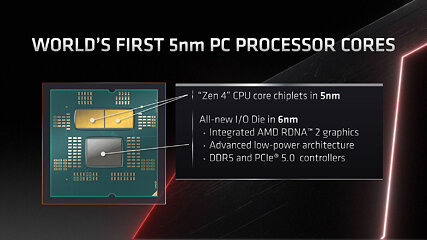 98
98
AMD Answers Our Zen 4 Tech Questions, with Robert Hallock
(98 Comments) »Introduction

AMD opened Computex 2022 with a bang by announcing its next-generation Ryzen 7000 "Zen 4" desktop processors and dozens of design wins for notebooks across all price points. According to public roadmaps, the second half of 2022 promises to be very busy for AMD, with the company launching not just these desktop processors, but also its 4th Gen EPYC "Genoa" enterprise processors and Radeon 7000 series RDNA 3 graphics cards. We have come to expect a double-digit percentage IPC gain with each generation of the "Zen" CPU architecture that breathed life back into the processor market, and in its fifth year in the market, "Zen 4" is expected to continue this trend.

During Computex, we caught up with Robert Hallock and asked him many questions we had, and also included things our community members brought up in numerous forum discussions in recent days. A big thank you goes out to the whole team at AMD who made this interview possible, and of course Robert who was kind enough to provide fascinating insights into how the Ryzen 7000 series is shaping up and what gamers and PC enthusiasts can expect from the next big AMD chip powering their battlestations.
What AMD Announced at Computex
Before we get into the interview itself, here's a quick recap of the Ryzen 7000 series—these are new-generation desktop processors by AMD built in the new Socket AM5 LGA package, which requires new motherboards. The switch to AM5 was required as the processors come with the latest I/O: DDR5 memory and PCI-Express Gen 5. The switch to a land-grid array makes the processors physically resilient, and as you'll soon know, there's good reason behind the odd polygonal shape of the integrated heatspreader (IHS) for these chips. At the heart of the Ryzen 7000 is the new "Zen 4" microarchitecture that comes with higher IPC and new capabilities compared to "Zen 3." The "Zen 4" CPU cores are built on the cutting-edge 5 nm EUV process, while the I/O die is made on the 6 nm process. Integrated RDNA2 graphics is now standard-issue, although there's more to this, as is a bigger PCI-Express 5.0 lane budget than what competing Intel processors offer.In its Computex 2022 presentation, AMD showed off an unnamed prototype Ryzen 7000 series processor playing AAA games. This chip was shown to be 16-core, 32-thread, which made us wonder if 16 is the maximum core-count for the Ryzen 7000 series at launch, much like the Ryzen 5000 series. Since all these 16 cores are what Intel would describe as "performance" cores, going in with 16-core, 32-thread as the maximum multi-core offering would be an indication that AMD is unfazed by Intel's E-core strategy to shore up multi-threaded performance. We began by asking AMD if 16-core, 32-thread indeed is the top dog of the Ryzen 7000 stack.
Our Patreon Silver Supporters can read articles in single-page format.
May 8th, 2024 23:07 EDT
change timezone
Latest GPU Drivers
New Forum Posts
- About to lose my mind with crashes/hangs: Is my 13700K dying? (4)
- Your way of cooling your PC? (47)
- Urgent: PC wont turn on with PSU connected to MOBO (32)
- Flash VBIOS to turn RX 580 2048SP into RX 570 (21)
- What are you playing? (20602)
- Epic Games launcher's ridiculous CPU usage (31)
- Post your Cinebench R23 Score (2954)
- Ubuntu 24.04 LTS released (10)
- POLL: Can you see the difference past 60fps (gaming/other) (59)
- Help for the non-tech but still logical re browsers and problems downloading apps (0)
Popular Reviews
- CHERRY XTRFY M64 Pro Review
- Corsair iCUE Link RX120 RGB 120 mm Fan Review
- Bykski CPU-XPR-C-I CPU Water Block Review - Amazing Value!
- Finalmouse UltralightX Review
- Upcoming Hardware Launches 2023 (Updated Feb 2024)
- Cougar Hotrod Royal Gaming Chair Review
- AMD Ryzen 7 7800X3D Review - The Best Gaming CPU
- Meze Audio LIRIC 2nd Generation Closed-Back Headphones Review
- ASRock NUC BOX-155H (Intel Core Ultra 7 155H) Review
- ASUS Radeon RX 7900 GRE TUF OC Review
Controversial News Posts
- Intel Statement on Stability Issues: "Motherboard Makers to Blame" (261)
- AMD to Redesign Ray Tracing Hardware on RDNA 4 (206)
- Windows 11 Now Officially Adware as Microsoft Embeds Ads in the Start Menu (167)
- NVIDIA to Only Launch the Flagship GeForce RTX 5090 in 2024, Rest of the Series in 2025 (142)
- Sony PlayStation 5 Pro Specifications Confirmed, Console Arrives Before Holidays (119)
- AMD's RDNA 4 GPUs Could Stick with 18 Gbps GDDR6 Memory (114)
- NVIDIA Points Intel Raptor Lake CPU Users to Get Help from Intel Amid System Instability Issues (106)
- AMD Ryzen 9 7900X3D Now at a Mouth-watering $329 (104)

